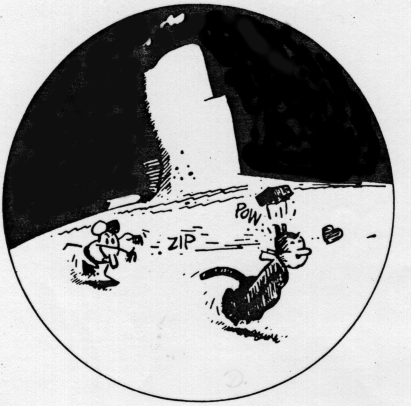
"Some Say it With A Brick": George Herriman's Krazy Kat
Written by Elisabeth Crocker
Cartoonist George Herriman effected his social critique by locating
Krazy Kat's identity almost exclusively in an overtly ideological naivete.
Krazy exposes the false consciousness of his companions through ignorance of
their habits and conventions; his naive misrecognitions of their kynical
misrecognitions deny their denial, pointing out the pretensions and
misrecognitions necessary for the maintenance of everyday life. More than
any other aspect of his character, this naivete fixes Krazy as an individual,
for some of the most powerful locators of individual identity -- gender and
race -- are transmutable in his character. Like the background scenes
of Coconino County where he lives, Krazy's gender and race shift, at random
sometimes, but more often according to his social situation. Herriman
couched his assertions about the socially-constructed nature of categories
like race and gender, as well as categories such as class, age, ethnicity,
and occupation, so deeply in the sophisticated allegory of his comic strip,
however, that few readers noticed them. Those who have written on
Krazy Kat to date have confined their comments to Herriman's drawing style and his
literary allusions, and to the more poignant but less puzzling aspects of the
love relationship between Krazy Kat and Ignatz Mouse. I focus
instead upon the cultural work Herriman was attempting, by drawing
attention to moments in which Herriman directly addresses issues of class,
ethnicity, gender, race, sexuality, and technology.
The situation of the characters remains unchanged over the course of the
strip's thirty-year run: Ignatz Mouse hates Krazy Kat with a violent
obsession that causes him to throw bricks at Krazy's head; Krazy loves
Ignatz with a singleminded passion that causes him to interpret the
projectiles as signs of Ignatz' love; Offissa Bull Pupp loves Krazy Kat and
hates Ignatz Mouse, and uses his lawful authority -- as well as his billy
club -- to protect Krazy from the bricks. Ignatz detests the "Kop," and
Krazy does not return Pupp's affection, although he does not resent the
intervention in his relationship with Ignatz. Krazy seems to understand
that others cannot see the brick as a token of affection, and he ignores
even Ignatz' own protestations to the contrary; he is always utterly
confident in his perception of the brick as a signifier of love.
The relationship between the three principals provides an ongoing
romance-plot, but it also frames subplots entailing the characters'
adjustment to new technologies and new discourses, and to the problems
an upwardly-mobile, mercantilist, service-industry bourgeoisie
encounters in its dealings with the laboring classes. Indeed, the
Sunday comics as a genre arose as a means of commentary on the rapidly
changing, increasingly stratified urban scene around the turn of the
century, with Richard Felton Outcault's "Yellow Kid" the first color
comic. The Kid, clad in a yellow jumper inscribed with his dialogue,
starred in Hogan's Alley, a series in the Sunday New York
World begun in
1895. Hogan's Alley is a street in a tenement neighborhood, whose
inhabitants are first- and second-generation European, mostly Irish
immigrants. The children of this slum are coarse and crass, and generally
troublemakers, but are also possessed of a beguiling innocence that allows
them to comment freely on the social injustice and hypocrisy they perceive
in the city dwellers. Noting the popularity of Outcault's strip, other
cartoonists picked up the immigrant and bad-boy themes, more and less
polemically and with more and less success. The Katzenjammer
Kids, Abie
the Agent, and Bringing Up Father, were among the more popular immigrant
strips, which employed the figure of the greenhorn both as the perpetrator
and as the butt ofjokes.
In 1901, about the time that George Herriman began drawing cartoons
for the Judge in New York, Outcault gave up the "Yellow Kid" and
started a strip in the Herald called Pore Lil' Mose, the first comic to
feature a sympathetic central character who was African American. The plot
began in Cottonville, Georgia, but Outcault soon moved Mose to New York
City, where he and his animal friends were in alien surroundings.
Outcault, though susceptible to the use of Sambo-like stereotyping for
a cheap laugh, nonetheless developed Mose's blackness into a more
complicated trope in his strip; race in Mose identifies the character
in New York as an immigrant in the extreme, the most visible kind of
outsider, and also points out the increasing disparity between rural
and urban American life. Migration from one part of the United States to
another had become as traumatic as that from another part of the world;
the farm country had become the Old Country.
Herriman, whose short-lived 1902 strip Musical Mose was clearly
derived from Outcault's Pore Lil' Mose, deployed this tropic use
of race in his own work. Most explicitly, he chose to make Krazy
a black cat when he introduced the character into his strip The
Dingbat Family, later called The Family Upstairs. The Dingbats dealt
with tenement life and the ever-pressing urban crowd, particularly in the
paranoid Upstairs features, in which the protagonists are constantly
harassed and tortured by their upstairs neighbors, whom neither the
Dingbats nor the readers ever see. The characters of Krazy and Ignatz
made guest appearances in the bottom margins of these strips, and moved
from the periphery to center stage in their own daily in 1913. Herriman
transplanted the black Krazy and the Jewish Ignatz from the cityscape
of New York to the desert of New Mexico, radically combining standard
representations of Old-to-New-World immigration and fulfilment of Manifest
Destiny with an inversion of the rural-to-urban migration theme, displacing
ethnicity and technology into the largely uninhabited county that is home to
the Grand Canyon.
Coconino County, the setting for the action in Krazy Kat, undergoes physical
transmutation from panel to panel. The stone of the desert, which in
so much American lore symbolizes the rugged indomitable frontier that
succumbs only to the rugged, indomitable spirit of the pioneer, instead
morphs from moment to moment between the natural and the built. Trees change
into buildings, then into rock formations, and cliffs become fortresses,
then shrink to pup-tents within a single episode, all without narrative
comment. This landscape, with all of the ethos and pathos of the high
desert, then, reflects the city nonetheless, for it is in cities that
forests are comprised of trees and lampposts in cohabitation, while dwellings
built to the scale of flat-topped mesas tower ominously over those whom
they're meant to shelter, and all is subject to change without notice as
the old is torn down to make way for the new. The perpetual motion of
Coconino, a city pretending to be a desert, epitomizes the perpetual
ideological and perceptual adjustments that the urban subject must make
in order to naturalize the city environment. Herriman elicits the
misrecognition of a landscape that is a city in order to bring to
light the everyday misrecognition of the city for a landscape.
The urbanites of Herriman's Coconino, nearly all children of immigrants
if not immigrants themselves, try continually to shake off old ethnic
identities that are wrapped up in homespun culture and the working class,
in an attempt to embrace a new, bourgeois, mechanically reproduced culture.
Herriman positions Krazy Kat in opposition to the other characters and their
aspirations to modernization and assimilation. Krazy has few, if any,
characteristics of the black stereotype of his time; instead, his
blackness locates him as a conspicuous outsider, and suggests the naivete of
the recent migrant or immigrant capable of illuminating for the reader the
pretensions and contradictions in the society Krazy's companions try to
create.
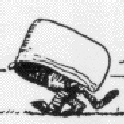
In the episode describing the humble origins of the
main characters
, Joe Stork,
"purveyor of progeny to prince and proletariat," who "pilots princes and
paupers, poets and peasants, puppies and pussycats across the river without
any other-side to the shore of here -- is telling `Krazy Kat' a tale which
might never be told and yet which everyone knows," detailing the
circumstances and places of birth of the various Coconinans. All come
from large families of inauspicious means: "`Ignatz Mouse' I brought
sightless and squirming and dropped him into an empty crackerbox," Joe says,
"And you, `Krazy', with four of your kind, I made comfortable in a
wash-boiler in the cellar of the haunted house -- and so it goes, and so it
goes." Meanwhile, "kindred souls gather at 'the Klub'" to boast of their
wealthy and noble upbringings, including Ignatz who proclaims, "Fair women
and brave men gathered about my cradle -- I was mighty even as an infant."
Upon leaving the Klub, the members encounter Krazy, carrying a washboiler
and singing a childhood song; Kolin Kelly the brick-seller exclaims, "Oh,
that us aristocrats has gotta breathe the same air as a `wash-boiler'-bred
boor --s'awfil," and the others chime in their concurring laments.
The discrepancy between Joe's stories of tenements and the narratives the
members invent at the Klub would be sufficient to prove their hypocrisy,
but their exclusion of Krazy from the Klub reveals the insecurity upon
which such hypocrisy is predicated. Clearly, it is not Krazy's low origins
that keep him out, but his unwillingness to misrepresent them;
meanwhile the Klub members require someone against whom they may define
themselves in their rush to join the assimilated bourgeoisie. They find
Krazy's refusal to forsake his sentimental attachment to his wash-boiler
repulsive because it stands for everything they are trying to leave behind.
With Krazy's class and immigrant status inscribed upon him with the color
of his fur, they exclude him from the Klub because he embodies the elements
within themselves they wish to exclude from their own identities.
Assimilation and modernization nearly coincide in a time when technology
moves with increasing speed and intrusiveness into everyday life; through the
alienating mechanization of labor and leisure, native-born citizens and
lifelong city-dwellers become immigrants in their own country, bumpkins in
their own city. As the residents of Coconino seize upon what they
perceive as the democratizing potential of technology, they fetishize
gadgetry and attach a superficial sophistication to the possession of and
facility with objects displaying the latest innovations. Yet Krazy Kat,
the urban bumpkin, feels dazzled by the new inventions. His
characteristic malapropisms and polyglossia express his admiration of
the new conveniences machines afford, while inadvertently warning gently
against uncritical acceptance and overdependence.
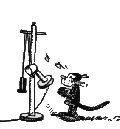
When electricity comes to Coconino County
, in 1921, Krazy
is duly impressed: "You turn off the light and turn on the dark, you turn off
the dark and turn on the light -- positivilly marvillainous." Krazy
significantly misspeaks here: in the conflation of "marvelous" and
"villainous" Herriman encapsulates ambivalence toward the induction of
electricity into the home. In a more serious critique of the ideological
ramifications of technological innovation, Krazy has a fruitless encounter
with a telephone, in 1923. Unfamiliar with terminology like "receiver" and
"hang up," Krazy cannot place a call. What is more important, he does
not understand the telephone as a medium of communication; he wishes to talk
"among" the telephone and addresses "Mrs. Telefoam" directly. Krazy's
naive misrecognition of the telephone, mistaking it for a subject with
whom one speaks, rather than an object-medium through which two subjects
speak, exposes the more typical misrecognition of telephone conversations as
direct interchanges between the speaking subjects, unaffected by their
object-medium.
Krazy's ignorance of contemporary discourse plays a large part in his
mishaps and misinterpretations, as he would be the first to admit. "Why is
`lenguage', `Ignatz'?" he asks in a 1918 daily. "`Language' is, that we may
understand one another," replies Ignatz, but the dissatisfied Krazy asks
whether "a Finn, or a Leplender, or a Oshkosher" can understand Ignatz
and vice-versa, to which Ignatz can only respond in the negative. "Then,
I would say," Krazy concludes, "lenguage is, that we may mis-unda-stend
each udda." His own language is a mixture of ethnic dialects, primarily
New York Yiddish and Tex-Mex Spanish accents, combined with anachronistic
syntax and literalized metaphors. The potential for ambiguity and
misinterpretation in language intrigues Krazy Kat, but he does not
deliberately employ it in an ambiguous manner. Herriman's narration of
the strips, however, relies upon the indeterminacy inherent in language to
draw out the instabilities in the subject-positions language constructs.
Such constructions of gender often come under fire in the polymorphous
identity of the Kat.
When questioned about Krazy's sex, even Herriman would respond that he
did not know, and the Kat did not seem sure either. "I don't know if
I should take a husband or a wife," Krazy complains in a 1915 daily.
"Take care," responds Ignatz, hurling his habitual brick. The narrator
nearly always refers to Krazy as "he," resolving awkward, ambiguous, or
gender-neutral moments to the pronoun "him," rather than to "her," or
"it." Most of Krazy's activity is not gender-specific, but in scenarios
involving some complication of his normal relationship with Ignatz,
Krazy adopts whichever gender role will restore the usual balance.
Cases of disguise or of mistaken identity in either Ignatz or Krazy, and
of rivalry with a party outside the Kat/Mouse/Pupp triangle, both elicit
gender-bending from the Kat.
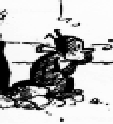 In one case, Krazy exhibits specificallymasculine behavior toward the "vemp" hen Pauline Pullet. She addresses him
as "Mister," and he doffs his hat and compliments her, "How riggle -- how
kwinly -- how statuary." In the next frame, however, he swears his undying
love for Ignatz: "But with all your beauty -- proud vemp -- you cant lure
me from "Ignatz" -- to he, I am for evva true," positing Pauline and
Ignatz as rivals for his love. Yet Krazy has placed Ignatz in the role
of Romeo to his own Juliet earlier on the same page, an allusion that
categorizes his affection for Ignatz as feminine love, which in turn makes
Pauline a potential rival for Ignatz' attentions (which she has been in the
past -- Krazy has commiserated with Mrs. Mice when Ignatz was out with the
Pullet). Krazy avoids the possibility of Pauline's competition by instead
competing with Ignatz for her, taking up the masculine courting rituals of
tipping the hat and over-complimenting. Krazy's masculine behavior, since it
causes Ignatz to be exposed to Offissa Pupp, achieves a dual victory for
him. Putting Ignatz out of the picture allows Krazy to maintain both
his masculine and his feminine romantic positions, reserving Pauline's
attentions for "Mr. Krazy Kat" and preventing her from diverting Ignatz'
attention from Krazy-as-Juliet.
In one case, Krazy exhibits specificallymasculine behavior toward the "vemp" hen Pauline Pullet. She addresses him
as "Mister," and he doffs his hat and compliments her, "How riggle -- how
kwinly -- how statuary." In the next frame, however, he swears his undying
love for Ignatz: "But with all your beauty -- proud vemp -- you cant lure
me from "Ignatz" -- to he, I am for evva true," positing Pauline and
Ignatz as rivals for his love. Yet Krazy has placed Ignatz in the role
of Romeo to his own Juliet earlier on the same page, an allusion that
categorizes his affection for Ignatz as feminine love, which in turn makes
Pauline a potential rival for Ignatz' attentions (which she has been in the
past -- Krazy has commiserated with Mrs. Mice when Ignatz was out with the
Pullet). Krazy avoids the possibility of Pauline's competition by instead
competing with Ignatz for her, taking up the masculine courting rituals of
tipping the hat and over-complimenting. Krazy's masculine behavior, since it
causes Ignatz to be exposed to Offissa Pupp, achieves a dual victory for
him. Putting Ignatz out of the picture allows Krazy to maintain both
his masculine and his feminine romantic positions, reserving Pauline's
attentions for "Mr. Krazy Kat" and preventing her from diverting Ignatz'
attention from Krazy-as-Juliet.
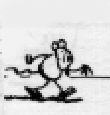 Roles in love play do not define the only parameters of gender construction
in Krazy Kat. Krazy is a black cat only in general, just as he is generally
male. When the Kat's fur changes color, however, his gender categorically
changes with it. In a 1918 Sunday page, Ignatz spies black male Krazy
poised upon the threshold of "Madame Kamouflage" beauty parlor, announcing
his intentions to look like the "Kwin of Shibba," a woman. Ignatz, startled
by Krazy's entry into the feminine space of the beauty parlor, exclaims,
"Daw-gawn!! Look what's going in that beauty parlor -- the nerve of
that `Krazy Kat'" (emphasis mine). Ignatz, with his choice of pronoun,
objectifies Krazy, like he objectifies the other women who go into "Madame
Kamouflage's," and expresses his momentary confusion about Krazy's gender
behavior. When the Kat is out of sight, Ignatz resolves the ambiguity in
favor of his usual perception of Krazy: "Wait 'til he comes out," he
threatens.
Roles in love play do not define the only parameters of gender construction
in Krazy Kat. Krazy is a black cat only in general, just as he is generally
male. When the Kat's fur changes color, however, his gender categorically
changes with it. In a 1918 Sunday page, Ignatz spies black male Krazy
poised upon the threshold of "Madame Kamouflage" beauty parlor, announcing
his intentions to look like the "Kwin of Shibba," a woman. Ignatz, startled
by Krazy's entry into the feminine space of the beauty parlor, exclaims,
"Daw-gawn!! Look what's going in that beauty parlor -- the nerve of
that `Krazy Kat'" (emphasis mine). Ignatz, with his choice of pronoun,
objectifies Krazy, like he objectifies the other women who go into "Madame
Kamouflage's," and expresses his momentary confusion about Krazy's gender
behavior. When the Kat is out of sight, Ignatz resolves the ambiguity in
favor of his usual perception of Krazy: "Wait 'til he comes out," he
threatens.
Upon seeing the Kat re-emerge bleached white, Ignatz calls Krazy a blonde,
with an e, and promptly asks her out on a date: "would'st dip thy beak in a
beaker of sassprilla with me, `snow-maiden', or would'st take a trip in
my air-ship?" Tossing aside his brick, he decides, "The deuce with that
Kat -- I cant waste time on him, with beautiful blondes like this running
wild." Krazy, when white, ceases not only to be male but ceases even
to be a Kat in the dazzled eyes of the mouse. Ignatz cannot recognize
Krazy when Krazy is white; whiteness in itself is for Ignatz an appropriate
object of erotic desire, which then in turn must be feminine. In a later
Sunday page, Ignatz again perceives a whitened Krazy Kat as female, and
"as white as a lily, pure as the driven snow," straightforwardly equating
whiteness with purity and beauty. Krazy's whiteness in this page is both
literally and figuratively white-wash, able to obscure whatever lies beneath
it, and to cleanse away Krazy's gender, Krazy's Katness, Krazy's very
identity.
Ignatz' inability to recognize Krazy when Krazy is white is necessary for the
continuation of their usual relationship; Ignatz normally "behurdils" his
brick as a token of his aggression toward Krazy, who receives it as a token
of affection. Krazy is a legitimate outlet for Ignatz' violent aggression
when the Kat is a black male, but a fellow white male could not be subjected
to that kind of violence, as it would potentially fragment and weaken the
network of white male dominance. So when the Kat appears white, he cannot
be the object of Ignatz' inter-male violence. A white female, however, is a
sanctioned object of white male aggression, especially when the aggression
is expressed as sexual desire. When the identity of Krazy -- or rather the
black and masculine constituents of Krazy's shifting subjectivity -- is
revealed, Ignatz is free to drop the pretense of adoration. He no longer
must ask Krazy out on a date to "take a trip in my air-ship", he can simply
hurl the phallic brick. Krazy identifies himself in both episodes; he cannot
tolerate the hypocrisy of Ignatz' courting behavior, preferring the less
mediated violent aggression.
For ostracized though he may be, Krazy has good reason for wishing to
maintain his position as the official Other of Coconino County; it gives him
license to shift roles at necessity and at whim, he has freedom in his
changeable identity. This freedom results from Herriman's understanding
that identity is constructed through the continual misrecognition of
political, social, and discursive parameters for natural constraints
on subjectivity. The destabilized identity of Krazy suggests the possibility
of a new, less fixed and more liberated kind of subject. Herriman could
not explicitly describe such a subject, but suggested it with the naive
inscrutability of the Kat, writing in 1917 to
... be not harsh with "Krazy" --
He is but a shadow himself, caught in the web of this mortal skein.
We call him "cat",
We call him "crazy",
Yet he is neither.
At some time he will ride away to you, people of the twilight.
His password will be the echoes of a vesper bell,
his coach a zephyr from the West --
Forgive him, for you will understand him no better than we who linger
on this side of the pale.
IATH WWW Server
Last Modified: Thursday, 28-Feb-2008 17:40:50 EST



 In one case, Krazy exhibits specificallymasculine behavior
In one case, Krazy exhibits specificallymasculine behavior Roles in love play do not define the only parameters of gender construction
in Krazy Kat
Roles in love play do not define the only parameters of gender construction
in Krazy Kat